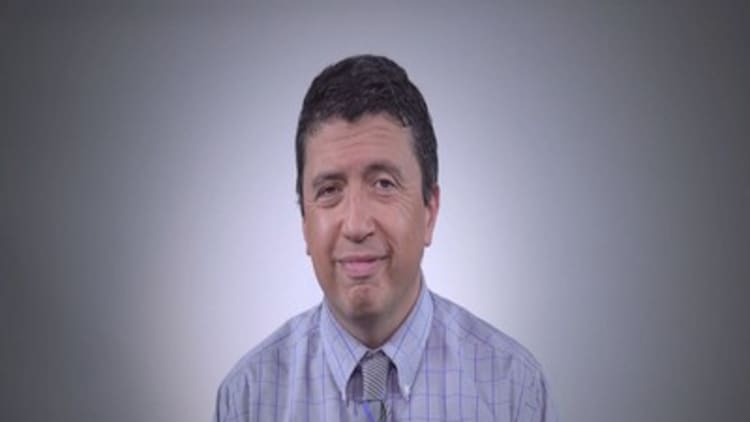
Maintaining zero interest rates for so long is creating a scenario in which containing risks "becomes virtually impossible," according to an analysis from a former Fed official.
A "muddled mandate" has the Fed too focused on unemployment at the expense of price stability, wrote Athanasios Orphanides, a global economics professor at the Massachusetts Institute of Technology's Sloan School of Management.
Former Fed boards knew enough to begin raising rates after long periods of accommodation well before the economy hit the full, or "natural," unemployment rate, said Orphanides, a respected former senior Fed advisor and member of both the European Central Bank and Central Bank of Cyprus. The paper outlining his views appeared on the St. Louis Fed website and is based on a June speech he gave to that branch of the U.S. central bank.
In the analysis, he paints a grim scenario should the Fed not choose to start hiking rates soon, calling the current scenario "the case of the missing liftoff." The unemployment rate, currently at 5.1 percent, equals the 5.5 percent rate that the Congressional Budget Office considered full employment back in February, signaling the Federal Open Market Committee is well behind when previous Feds chose to begin raising rates, he said.
"If policymakers wish to ensure full employment and price stability over time, they cannot afford to permit immense policy accommodation in the system once full employment is reached," Orphanides wrote. "If they did, it would not be feasible to withdraw that accommodation on time without either generating inflation or tightening so abruptly it could cause a recession. For this reason, policy normalization ought to commence long before reasonable estimates suggest full employment has been restored."
The FOMC a week ago chose to delay again lifting its key funds rate off near zero where it has been since late 2008. That policy has come even though the headline unemployment rate is half where it was at its 2009 peak and the economy has not seen consecutive quarters of negative growth since the Great Recession ended.
Read More Bill Gross to the Fed: 'Get off zero, now!'
Fed Chair Janet Yellen will be speaking later Thursday, with market participants hoping for clues about whether the committee will move at all this year toward normalization.
Orphanides' paper comes at an interesting time for the St. Louis Fed: A report also issued over the summer contended that the Fed's monthly bond-buying program, or quantitative easing, that brought its balance sheet past $4.5 trillion basically failed to generate the central bank's economic objectives. Also, St.. Louis Fed President James Bullard, a nonvoting member of the FOMC, said after the meeting that given the chance he would have dissented from the committee's decision not to raise rates.
While critics fear the long-term inflation that the zero interest rate policy, or ZIRP, could generate, Fed officials worry about the opposite, namely that all of the liquidity and low rates have yet to generate inflation as measured by the committee's preferred indicators. Yellen herself also takes into account a more encompassing jobless rate that includes those who have quit looking for look or working part time for economic reasons, a rate that remains elevated at 10.3 percent.
To get past the policy confusion, Orphanides recommends the approach that previous Feds followed, particularly after recessions in 1981, 1990 and 2001.
Read More When the Fed raises rates, here's what happens
"The Federal Reserve followed this prudent, pre-emptive approach after every recession in recent decades. This strategy kept inflation in line with reasonable price stability and avoided stop-go cycles and abrupt and costly corrections. Not this time," he said. "Six years after the end of the Great Recession, the Federal Reserve has yet to begin the process of normalization from the unprecedented monetary accommodation it engineered during and after the Great Recession."
That likely will be the case for a while yet, though many on Wall Street are still predicting the Fed to hike before the end of the year.
Traders assign just an 11 percent chance the FOMC moves in October, a 35 percent chance of a December hike and a 46 percent probability for January. March carries the best chance ahead, with a 61 percent likelihood.
Read More Fed's window for 2015 rate hike is closing quickly
Ultimately, Orphanides fears, by the time the Fed does move it could be too late. He recommends the central bank forget its dual mandate of full employment and price stability and instead come up with a hard-and-fast policy of when it will raise rates. The Fed has tried setting economic benchmarks, but moved them when officials were dissatisfied with overall conditions.
"Fear of liftoff raises the odds that the Fed will soon be confronted with a costly dilemma: Tighten policy abruptly to control inflation, precipitating a recession? Or let the inflation genie out of the bottle to avoid recession?" Orphanides said. "The greater the delay, the greater the risk that an orderly unwinding of monetary policy accommodation becomes virtually impossible."






